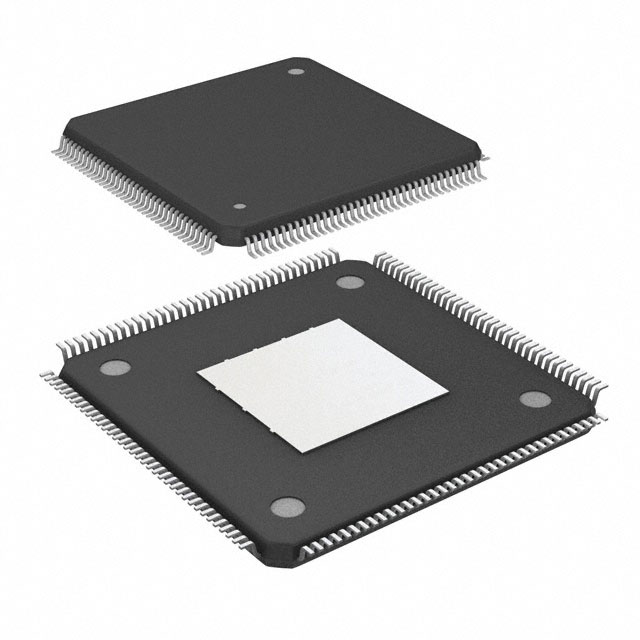Viz Specifikace pro podrobnosti o produktu.

EP3C10E144C8N
Product Overview
Category
EP3C10E144C8N belongs to the category of programmable logic devices (PLDs).
Use
This device is commonly used in various electronic applications that require programmable logic functions.
Characteristics
- EP3C10E144C8N is a high-performance PLD with advanced features.
- It offers flexibility and versatility in designing digital circuits.
- The device supports reprogramming, allowing for easy modifications during development stages.
- EP3C10E144C8N provides efficient power management capabilities.
- It is designed to operate at low power consumption levels.
Package
The EP3C10E144C8N comes in a compact and durable package, ensuring protection during handling and installation.
Essence
The essence of EP3C10E144C8N lies in its ability to provide a customizable and reprogrammable solution for digital circuit design.
Packaging/Quantity
This product is typically packaged in trays or reels, depending on the quantity ordered. The standard packaging includes 100 units per tray/reel.
Specifications
- Device Model: EP3C10E144C8N
- Logic Elements: 10,080
- Maximum User I/Os: 101
- Embedded Memory: 414,720 bits
- Operating Voltage: 1.2V
- Speed Grade: C8
- Package Type: 144-pin Enhanced Plastic Quad Flat Pack (EPQFP)
Detailed Pin Configuration
The EP3C10E144C8N has a total of 144 pins, each serving a specific function within the device's architecture. The detailed pin configuration can be found in the manufacturer's datasheet.
Functional Features
- High-speed performance: EP3C10E144C8N operates at fast clock frequencies, enabling efficient data processing.
- Flexible I/O options: The device offers a wide range of input/output configurations, allowing for versatile connectivity.
- On-chip memory: EP3C10E144C8N includes embedded memory blocks, reducing the need for external memory components.
- Programmable logic: The PLD can be programmed to implement various digital functions, providing design flexibility.
Advantages and Disadvantages
Advantages
- Versatile and customizable solution for digital circuit design.
- Reprogrammable nature allows for easy modifications during development stages.
- Efficient power management capabilities.
- Compact package ensures protection and ease of installation.
Disadvantages
- Limited logic elements compared to higher-end PLDs.
- May require additional support components for complex designs.
Working Principles
EP3C10E144C8N operates based on the principles of programmable logic. It consists of configurable logic blocks (CLBs), interconnect resources, and embedded memory. The device can be programmed using hardware description languages (HDL) or graphical design tools to define the desired digital circuit functionality.
Detailed Application Field Plans
EP3C10E144C8N finds applications in various fields, including but not limited to: 1. Industrial automation: Control systems, motor drives, and robotics. 2. Communication systems: Network routers, switches, and protocol converters. 3. Consumer electronics: Set-top boxes, gaming consoles, and multimedia devices. 4. Automotive electronics: Engine control units, infotainment systems, and driver assistance systems. 5. Medical equipment: Patient monitoring devices, diagnostic instruments, and imaging systems.
Detailed and Complete Alternative Models
- EP3C16E144C8N: Similar to EP3C10E144C8N but with increased logic elements (16,128).
- EP3C25E144C8N: Offers higher logic capacity (24,192) and additional features for more complex designs.
- EP3C40E144C8N: Provides even greater logic capacity (39,600) and enhanced performance capabilities.
These alternative models offer increased resources and functionality compared to EP3C10E144C8N, catering to different design requirements.
Word count: 536 words
Seznam 10 běžných otázek a odpovědí souvisejících s aplikací EP3C10E144C8N v technických řešeních
Sure! Here are 10 common questions and answers related to the application of EP3C10E144C8N in technical solutions:
Q: What is EP3C10E144C8N? A: EP3C10E144C8N is a specific model of Field-Programmable Gate Array (FPGA) manufactured by Intel (formerly Altera). It offers 10,000 logic elements and comes in a 144-pin package.
Q: What are the main advantages of using EP3C10E144C8N in technical solutions? A: The main advantages include its reprogrammability, high performance, low power consumption, and ability to implement complex digital circuits.
Q: In what kind of applications can EP3C10E144C8N be used? A: EP3C10E144C8N can be used in various applications such as industrial automation, telecommunications, automotive electronics, medical devices, and many more.
Q: How do I program EP3C10E144C8N? A: EP3C10E144C8N can be programmed using hardware description languages (HDLs) like VHDL or Verilog, which describe the desired functionality of the circuit.
Q: Can EP3C10E144C8N interface with other components or devices? A: Yes, EP3C10E144C8N supports various communication protocols like SPI, I2C, UART, and Ethernet, allowing it to interface with other components or devices.
Q: Is EP3C10E144C8N suitable for real-time applications? A: Yes, EP3C10E144C8N is capable of handling real-time applications due to its high-speed processing capabilities and low-latency design.
Q: Can EP3C10E144C8N be used for signal processing tasks? A: Absolutely, EP3C10E144C8N can be utilized for various signal processing tasks such as filtering, image processing, audio/video processing, and more.
Q: What kind of development tools are available for programming EP3C10E144C8N? A: Intel provides Quartus Prime software suite, which includes a powerful Integrated Development Environment (IDE) for designing, simulating, and programming FPGAs like EP3C10E144C8N.
Q: Are there any limitations or constraints to consider when using EP3C10E144C8N? A: EP3C10E144C8N has limited logic elements compared to higher-end FPGAs, so complex designs may require a larger FPGA model. Additionally, power consumption should be considered for battery-powered applications.
Q: Where can I find additional resources and support for EP3C10E144C8N? A: Intel's website provides comprehensive documentation, datasheets, application notes, and an active community forum where you can find additional resources and support for EP3C10E144C8N.
Please note that the specific details and answers may vary depending on the context and requirements of your technical solution.

